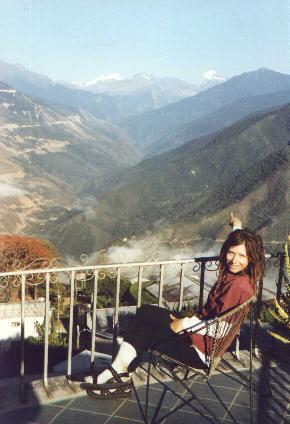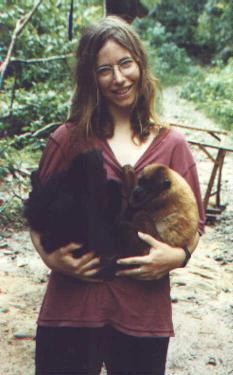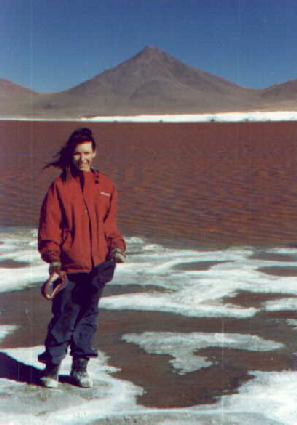
Coroico is a relaxing weekend resort of the rich people of La Paz.
Sent: Sun, 5 Oct 1997 03:45:16 +0200 (GMT+0200)
In the morning, up in the sky, there was no sign of the storm - clear blue sky and lovely warm sun shined above us. However, down on mother earth, 30cm of fresh new snow accumulated during the night. We started to walk, snow up to our knees, but as we were going down the valley, 3 hours later we were back again on solid (but wet, as our shoes were) ground....
We arrived to a point where one can connect to, as written in our guidebook "The premium and most popular trek in Bolivia", the "Choro trek". The trek itself is 4 days hike from a pass of 4,800m (The bus brings you 100m below the top, so it isn't difficult) down hill till 1,600m. We connected somewhere around 3,600m and had two more long days to finish. In our way we saw a shepherd hitting with a stick the alpacas which weighted 10 times more than her. She was only 3 years old... I will just remark that in this "premium" walk we didn't see any tourist except in the very last hour, where we met 8 tourists from... Israel!
In the end of the trek we arrived to the relaxing weekend resort of the rich people of La Paz, Coroico. As it is 1,700m, it is almost tropical, and every hotel (including ours!) had a swimming pool. What a nice way to end a trek !

Coroico is a relaxing weekend resort of the rich people of La Paz.
We took a bus to Cochabamba, the big city on the way. Just to let you know, the average bus terminal in Bolivia is like 2 floors of Tel Aviv's new bus station, and the buses are like the new, high, modern tourist buses in Israel. EGED buses are considered here "אוטובוסים סוג ב'" or, if you like "אוטובוסים לעניים". From there we took a small van the Villa Tunari. The region is purely jungle (100m of altitude) and is the coca growing area (coca is the raw material for the production of cocaine, one of the biggest exports of Bolivia). As USA supports Bolivia's economy, they got the permission from Bolivia's government to send secret agents to combat the drug producing people. Like this the local population is very hostile to white men (sometimes they kill these American agents) and it is especially dangerous for tourists to be there as they can be mistakenly confused with these American agents...
We arrived to Villa Tunari and discovered that the stories were true. In a small area, monkeys, big turtles, parrots, deers and what is called in Hebrew בואש were living together. It was not a cage, they could always get out, but they always came back for the food. The target of this place, which is run by volunteers, is to teach these animals to adapt themselves to live in the nature. The monkeys were especially friendly and all the time played with us, human beings. They set on us, jumped on us and virtually didn't touch the ground. It was nice, but had some disadvantages, for instance they also did their WC on us... or when one too friendly monkey took the macro ring of my camera and ran away. It took almost an hour to take it back from him. A BOESH insisted on trying to remove a patch from my pants. It reacted quite violently against my attempts to prevent him from doing so.

The monkeys were especially friendly.
It's time to move to Chile. We planned to do it by taking the famous "Salar de Uyuni" 4WD tour until the border with Chile. The normal price for a 4 days tour is 60 $US, but as we arrived in the high season, the town was packed with pale Europeans who don't know what bargaining is, and were ready to pay whatever priced they were asked to. Like this prices soared up to 100 $US, a fortune in local standards. In the end we succeeded to find a low priced tour, but with an organised group of elderly spoiled western people. In this tour we past through the Salar de Uyuni, which is the largest salt desert in the world. In the middle of it there is a hill full of huge cactuses, and also a hotel made of salt. From ground to roof through the chairs and tables. Then we visited the south west part of Bolivia, which is a desert area full of rock formations, dunes and lagoons with flamingos. Really amazing.
Last night of the tour we slept nearby Laguna Colorada, at 4,250m. This is a really RED coloured lagoon due to the reflection and algae in the water. In that night we went to dance and drink beer in the world's highest disco...

Laguna Colorada.
| [ Next ] | [ Previous ] | [ Index ] | [ Homepage ] |